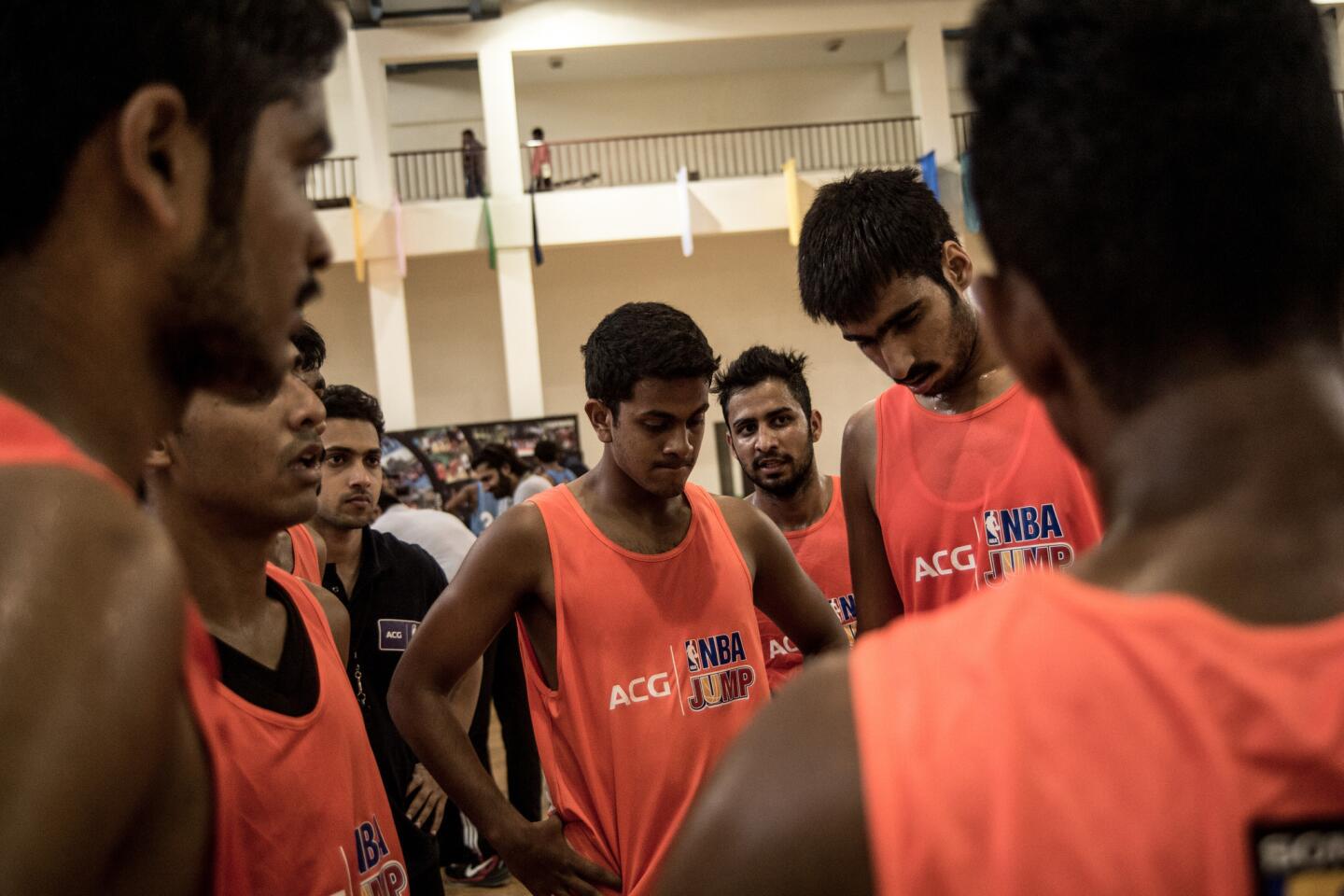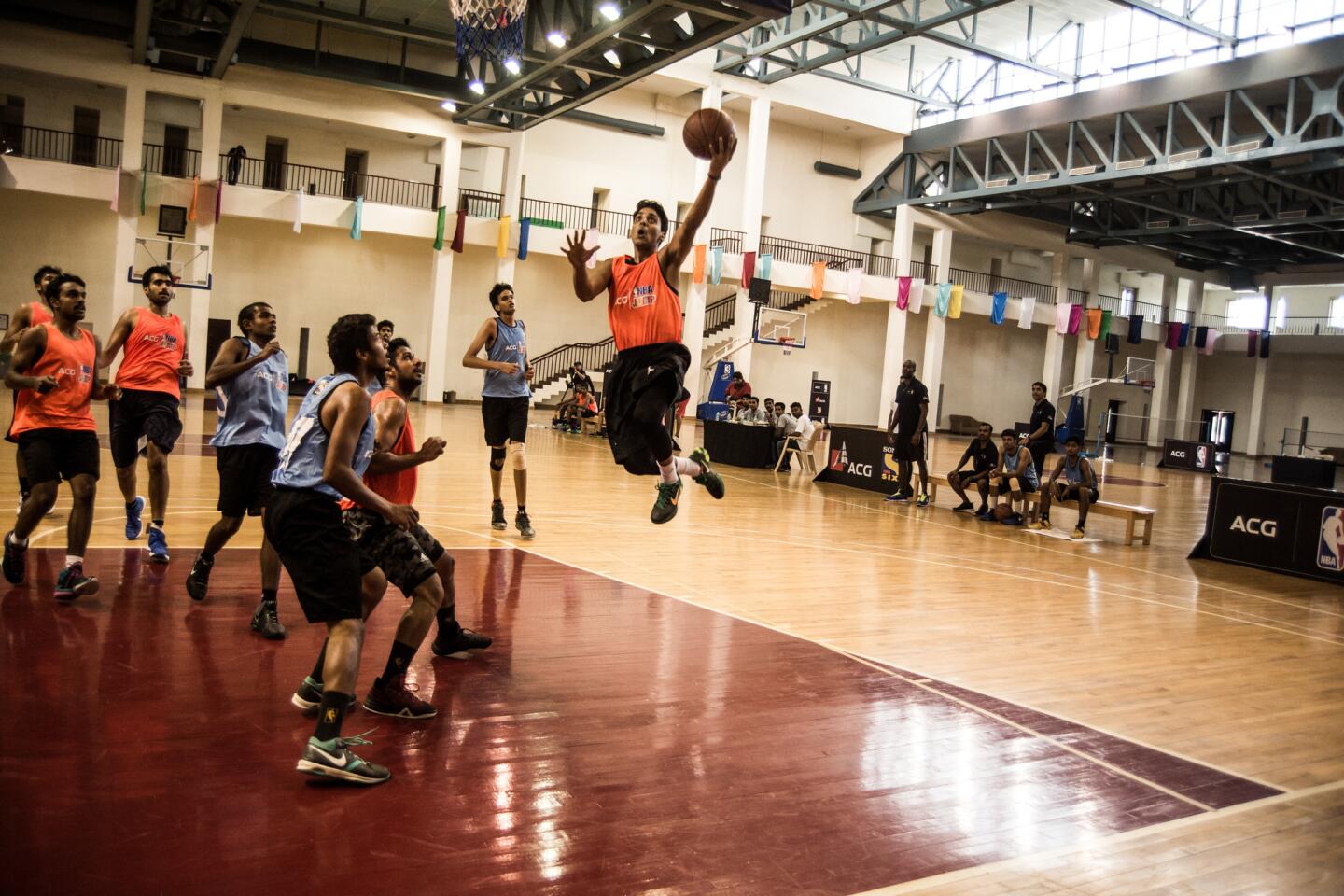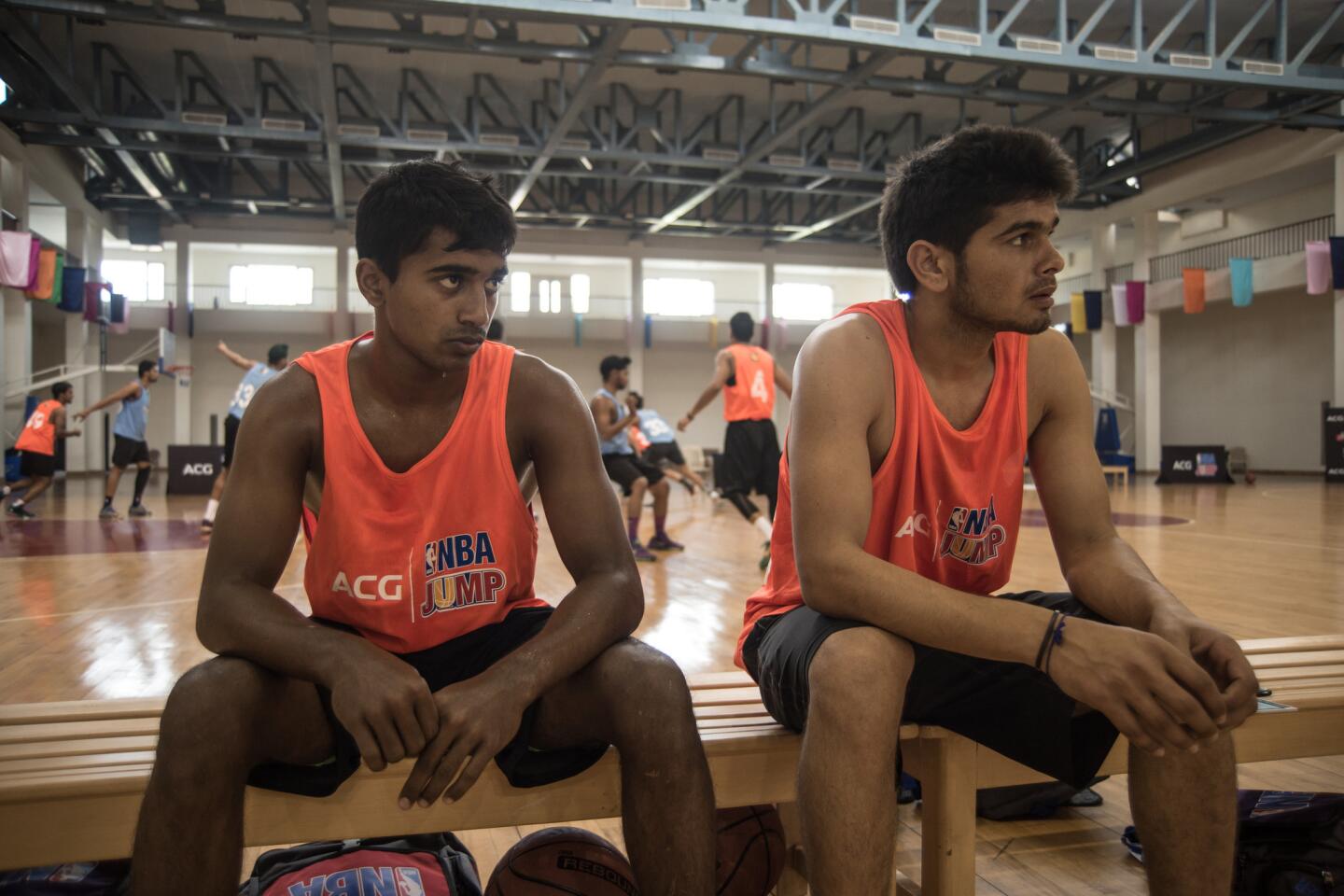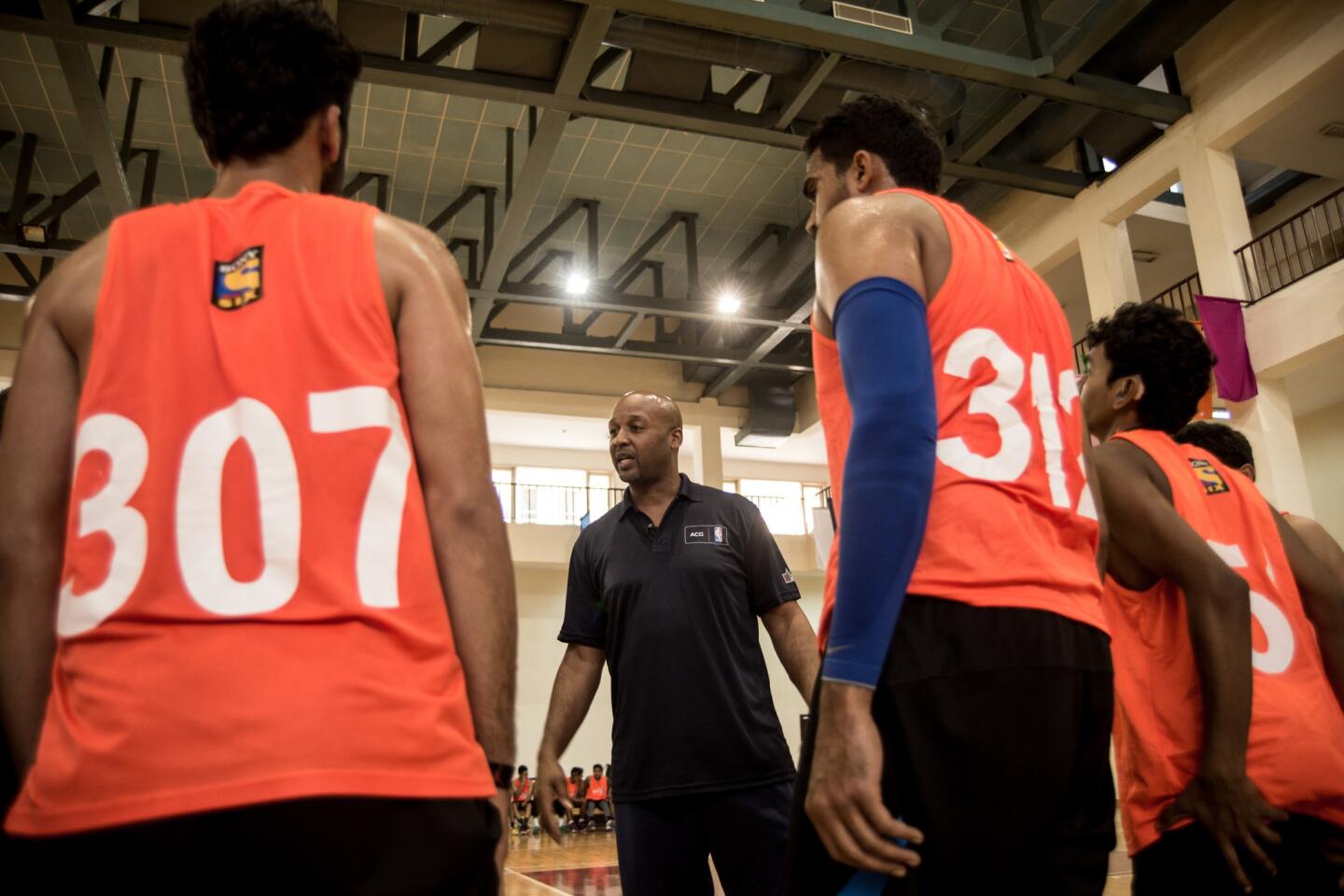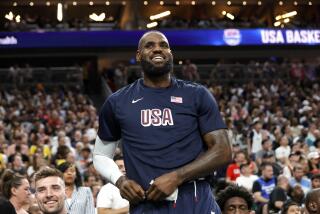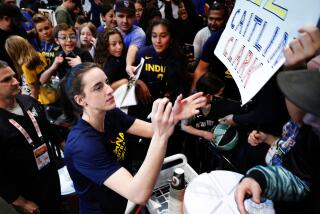Searching for the next NBA sensation in the world’s second most populous nation
- Share via
Reporting from GREATER NOIDA, India — Loveneet Singh Atwal was just a scrawny fifth-grader, still learning his way around the basketball courts of his native Punjab, when he persuaded his father to let him get a tattoo.
The letters on his right biceps spell “N-B-A.”
------------
FOR THE RECORD
March 11, 8:15 a.m.: The headline on an earlier version of this article incorrectly stated India was the world’s most populous nation. It is the world’s second most populous nation.
------------
Atwal, now 20, found himself tantalizingly close to his dream in February when he was one of 32 promising young Indian players invited to compete for a tryout with the NBA Development League, the organization’s minor league.
With his gray Nikes and Air Jordan socks stuffed into a suitcase, Atwal arrived at a plush private sports complex outside New Delhi, a far cry from the derelict state-funded academy where he trained as a boy. After a four-day camp, coaches would select one hopeful to compete at the D-League trials, moving him a step closer to an almost unthinkable opportunity: to become the first Indian to play in the NBA.

The talent search is on for the latest piece of the NBA’s full-court press into India.
“It’s my dream, it’s my family’s dream,” Atwal said. “I want to go to America.”
The talent search was the latest piece of the NBA’s full-court press into the world’s second most populous nation.
More than other major U.S. sports leagues, the NBA has adopted a strategy to expand its global reach and now generates hundreds of millions of dollars a year from broadcasting and licensing deals in China, Brazil and other foreign markets. While NBA franchises earned $5.2 billion domestically last season, the league’s international business is growing — and could get a major boost from India’s 1.25 billion people.
Setting out to create a basketball culture almost from scratch, the league has deployed dozens of coaches across India to teach the game on pockmarked courts and in stuffy public gyms. It has launched a traveling festival and three-on-three tournament that will reach 24 cities this year and made basketball part of the physical-education curriculum in more than 1,000 schools.
The NBA has also stepped up efforts to find a homegrown star to carry its banner in a country where less than half of 1% of the population plays basketball.
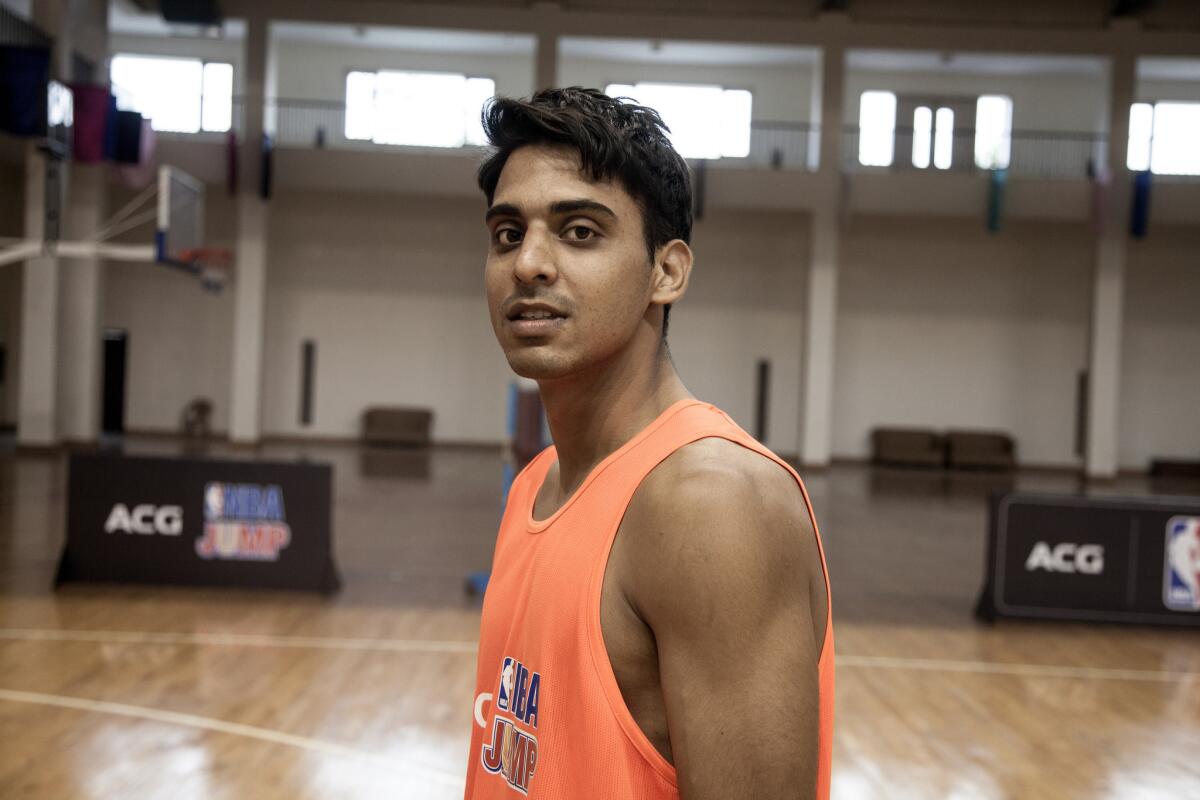
Loveneet Singh Atwal was one of 32 promising young Indian players invited to a tryout for the NBA’s Development League at a sports complex in Greater Noida, near New Delhi.
“The goal is to show that 11-year-old out there who loves the game that there is a pathway to success,” said Yannick Colaco, the NBA’s managing director in India. “But it’s also about spreading the game and getting people in this country to appreciate basketball as a great sport.”
As it stands, India’s basketball infrastructure is weak. Scott Flemming, an American who coached the Indian men’s national team until last year, said that at government-run gyms, holes in the hardwood courts were stuffed with cement or wads of paper. Hydraulics on baskets were often broken, so a regulation 10-foot-high rim would sink to 8 feet by the end of a two-hour practice.
In addition, most players come to the game too late.
“The best players in India don’t start playing until they’re 13 or 14 years old, whereas in other countries kids are playing a lot at age 7 or 8,” said Flemming, now the head coach at Northwest Nazarene University, a Division-II school in Idaho.
NBA officials said they are confident basketball will catch on with an expanding Indian middle class that has shown a taste for fast-paced international games like soccer. Even staid cricket, long India’s most popular sport, has updated its appeal with a condensed, flashier version that packs the languorous game into three-hour matches — with pompom-wielding cheerleaders gyrating on the sidelines.
The NBA’s TV audience in India tripled in 2015 from the previous year, but the average game still draws just 300,000 viewers — half the population of Memphis, the smallest market with an NBA team.
“NBA basketball has the largest opportunity of any sport in this country,” Colaco said. “Consumers want what the NBA has.”
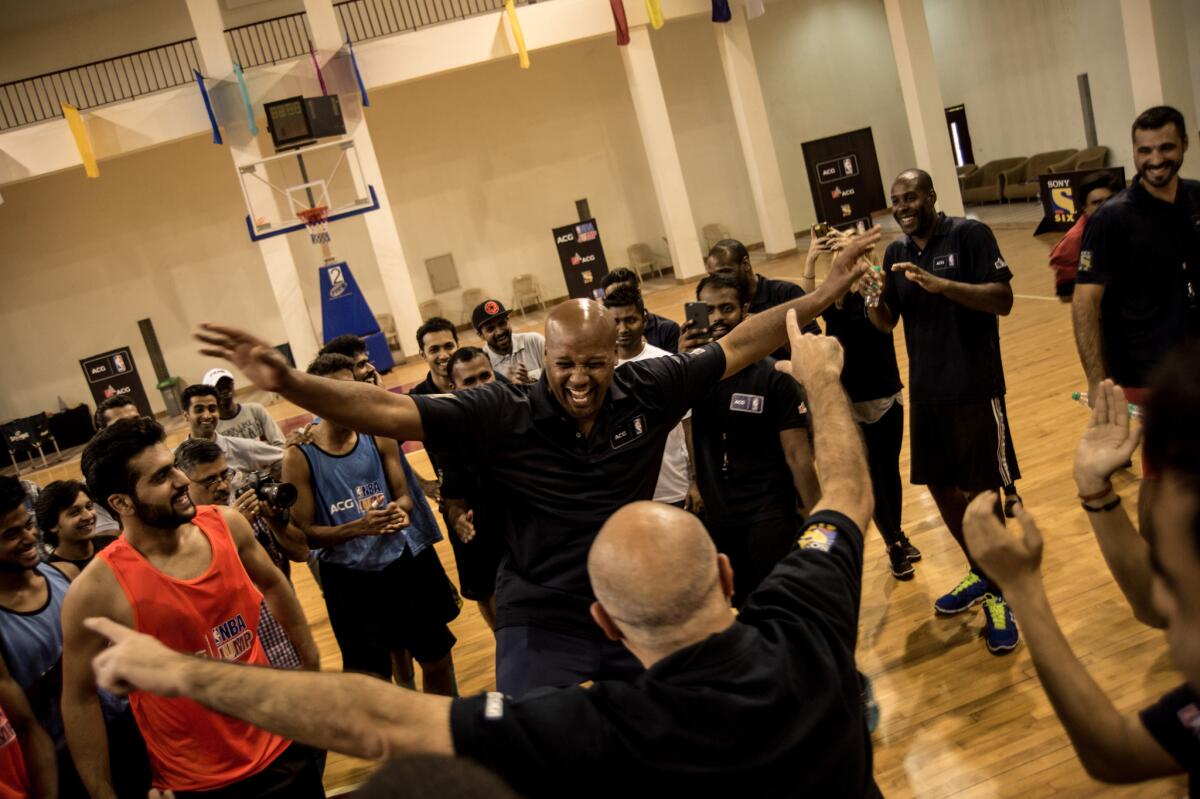
Former Laker Brian Shaw breaks into a dance routine with coaches and players.
What the league doesn’t have yet is India’s answer to Yao Ming, the towering Chinese star who helped basketball explode in his native country after he entered the league with the Houston Rockets in 2002. A Chinese Internet company, Tencent, recently agreed to pay an estimated $500 million over five years for the rights to stream NBA games and highlights.
At the start of this season, league rosters included players from 37 countries and territories. Vivek Ranadive, an Indian-born businessman who is majority owner of the Sacramento Kings, said that “as more [Indian] children learn and play the game, they’ll look for superstars to call their own.”
Ranadive has injected a subcontinental flair into his franchise with annual Bollywood-themed home games. Last year the Kings signed Sim Bhullar — whose parents emigrated from Punjab — to a 10-day contract, making the 7-foot-5 Canadian the first person of Indian descent to play in the NBA. He was then sent back to the D-League.
A few months later, the Dallas Mavericks made another big man, Satnam Singh Bhamara, the first Indian selected in the NBA draft when the team chose him as the 52nd overall pick.
Bhamara, who is currently in the D-League and stands a good chance of being promoted to the NBA in a few years, also hails from Punjab, a sports-crazed northern state. At the Ludhiana Basketball Academy, a dilapidated facility that has often lacked running water and air-conditioning, he played alongside Atwal, who stands more than a foot shorter at 5-foot-11.
NBA basketball has the largest opportunity of any sport in this country. Consumers want what the NBA has.
— Yannick Colaco, the NBA’s managing director in India
Atwal learned the game from his father, a former player who began teaching him and his twin brother, Khushmeet, at age 7. Both boys became standout guards, but the sinewy Loveneet became known for his breakneck speed, no-look passes and swagger worthy of his idol, the Chicago Bulls’ Derrick Rose.
He played in junior tournaments across Asia and chronicled his rise on Facebook and Instagram: splitting a pair of Syrian defenders during a game in Mongolia, being guarded by former NBA all-defensive player Raja Bell at an NBA event in India, flashing his six-pack in the weight room.
When the NBA launched its talent search last fall, Atwal had already started a career at Indian Railways, a government agency that recruited him to play for its basketball team, which competes nationally. He makes $400 a month as a ticket collector — an above-average salary in India — but gets little time on court.
See the most-read stories this hour >>
“They don’t play that many games,” said Carlos Barroca, a former Portuguese national coach who now runs the NBA’s training programs in India. “Players have the talent and the desire, but the way the system is set up here they can spend months without competition.”
In December, the NBA held a daylong event in Mumbai to select players for the national tryout. Atwal showed up slightly out of shape — having spent the previous month at a railways training center several hours away, with no basketball court. But he still dominated most of the other 18-to-22-year-olds and easily advanced.
For the national tryout last month, the NBA and its partner, pharmaceutical conglomerate ACG, reserved a palatial gym with four indoor courts in Greater Noida, a New Delhi exurb. In addition to the player selected for the D-League trials, four others would be chosen to represent India in an international three-on-three tournament this year.
On the last morning of the camp, Atwal started at point guard in front of several international NBA coaches and brimmed with intensity. He drained a three-point shot at one end of the floor, then was called for a foul on defense. He screamed, drawing stares from the coaches.
A teammate came over and put a hand on his head. Atwal walked over to the referee and shook his hand in a gesture of apology.
Moments later, on a fast break, Atwal tried a no-look pass to his center, who fumbled the ball out of bounds. Atwal glared at the rafters in frustration.
When the final whistle blew, Atwal’s team had lost. He walked off the court rubbing his knees, which were bruised from two hard falls.
Barroca called the players to the center of the floor, congratulated everyone and began reading the names of the top 10 players. At No. 6, Barroca said, “This breaks my heart,” and announced Atwal’s name.
Atwal’s English is spotty, and it took him a few minutes to realize he had come up one place short. He stood in a corner of the floor, clutching the black high-tops he was given as consolation.
“Hard luck, man,” another player said.
The winner of the D-League tryout, Palpreet Singh, 21, had a prototypical NBA body: 6-foot-8 with big, soft hands. He had only been playing since 2010, but coaches loved his footwork and planned to tailor a training program to get him ready for the trials in June.
Barroca said that Atwal was a little too small and not yet skilled enough at cutting to the basket.
Atwal said that he would like another shot at the NBA. “I know I only have eight or nine more years that I can play, and then my body won’t be as strong,” he said. “But I will keep trying.”
Two weeks after the tryout, he was back at the railways training center, jogging and lifting weights, but taking a short break from basketball while he studied for a civil service exam.
ALSO
How the 1981 assassination attempt changed Nancy Reagan
Brentwood neighbors want city to punish landowner over tree removal
Aiming to drive down gun deaths? Put these three laws on the books, researchers say
More to Read
Sign up for Essential California
The most important California stories and recommendations in your inbox every morning.
You may occasionally receive promotional content from the Los Angeles Times.

